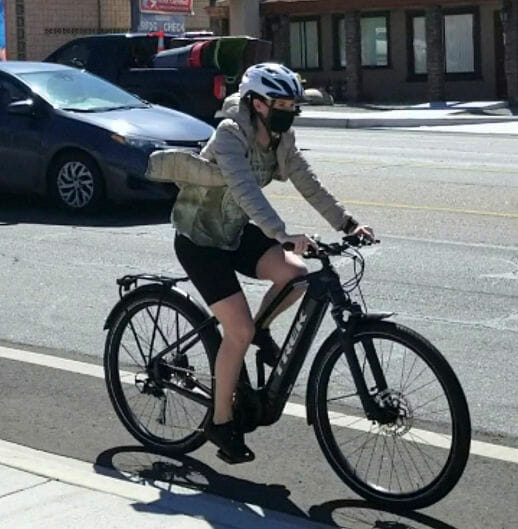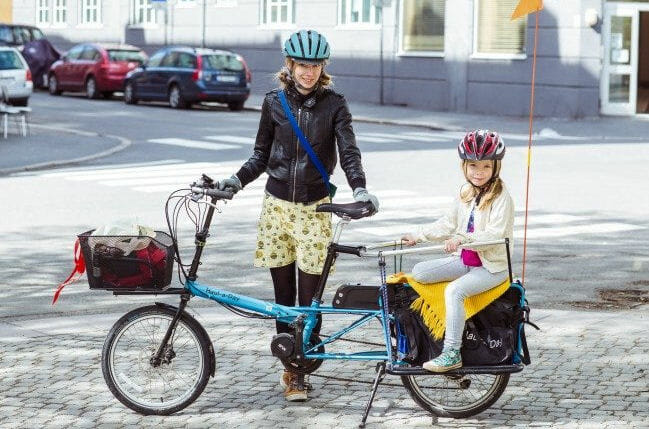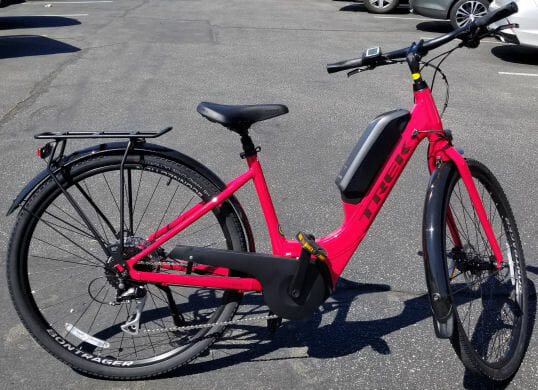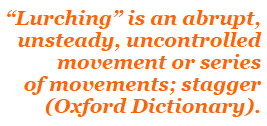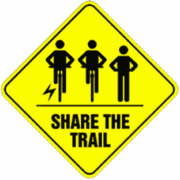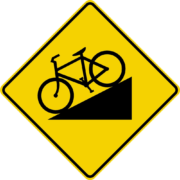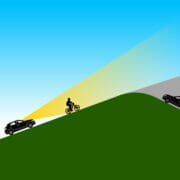Ebike Benefits and Challenges – It’s a Different Machine!
This article is Part Four of a series on e-bikes. Previous articles are Savvy E-Biking To A Car-Free Future, Everyone’s A Racer Now, and E-Bikes: Education, Training & The Law. I encourage you to read those three articles before continuing with this one.
This article will focus on the benefits (advantages) and challenges (disadvantages) of e-bike use. The fifth article will focus on misconceptions, etiquette, and mixed-group riding (conventional bikes and e-bikes).
The E-Bike Surge
E- bike (electric bike) sales and use continue to grow here in the U.S., Europe, and beyond. It’s noted here: US e-bike imports double this year to over half a million, but it’s not enough (electrek.co).
This good news exposes the need for traffic education and training for everyone—old to young, skilled to unskilled, and experienced to novice—driving these faster, heavier, and at times less nimble e-bikes.
E-Bike Benefits
The bicycle industry and community are good at promoting the benefits and advantages of e-bikes:
- Dependable option for people limited by fitness, age, or disability
- Great Equalizer, allowing the entire family, friends, or ride partners to ride together
- Eco-friendly and reduce traffic congestion
- Promote health and fitness
- Provide for socially-distanced commuting
- Require no driver’s license, vehicle registration, or insurance (may vary state to state)
- Make parking EASY; no fees involved
E-bikes also REMOVE the “Too Barriers.” These are common excuses not to ride a bicycle. They include:
- Too far
- Too long
- Too hard
- Too hilly
- Too sweaty or fatigued
- Too hot or windy
Additionally, some e-bikes can carry bulky cargo and children, as pictured here.
Bike-Handling Challenges
To be fair, we must also discuss the challenges to using an e-bike. E-bikes are faster, heavier, and at times less nimble than their “conventional” counterparts. Some skills can be more awkward and/or challenging, for example:
Mounts and Dismounts:
These are an issue for unskilled, inexperienced, and/or older persons—including with balance issues.
I encourage everyone to read The Top Three Essential Bike-Handling Skills | CyclingSavvy article. It includes the “Starting and Stopping” lesson from the free Essentials Short Course. Also read the Learn to Ride the Easy Way as an Adult Beginner | CyclingSavvy article. Both these articles are excellent starting points for anyone wanting to use an e-bike.
For beginners or less skilled riders, it is extremely important to keep the power to the motor (drive unit) OFF when mounting or dismounting an e-bike. This is different from stopping and starting during a ride, normally done in a lower support/assist/power mode.
Turning off the motor eliminates “lurching,” which can occur with either a throttle-assisted or pedal-assist-only e-bike. Unexpected lurching could cause you to lose your balance, fall off, and injure yourself.
It is also important to “lock your bike down” when mounting or dismounting! Apply the left brake lever (front brake) before you mount or dismount, to prevent the bike from rolling out from under you. It is usually best to mount or dismount a bicycle from the left (non-drivetrain) side.
A “low-step” framed e-bike is easier to mount and dismount, and may be an excellent choice for less skilled and/or older riders.
More Bike-Handling Issues
-
 Starting and stopping: Once again, “lurching” and/or “motor overrun” can occur, so be careful not to apply too much pressure to the pedals. “Motor overrun” occurs after pedaling hard and then stopping pedaling, as the motor may turn a few more revolutions. This will momentarily keep power to the e-bike’s drivetrain.
Starting and stopping: Once again, “lurching” and/or “motor overrun” can occur, so be careful not to apply too much pressure to the pedals. “Motor overrun” occurs after pedaling hard and then stopping pedaling, as the motor may turn a few more revolutions. This will momentarily keep power to the e-bike’s drivetrain.
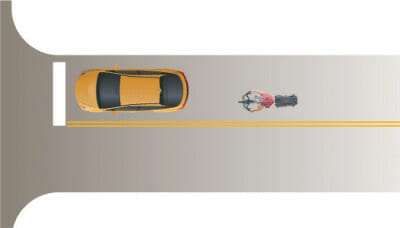
Normal distance behind a car on a conventional bike
As mentioned in the Part Two article, CSI Brian Cox, a fellow e-bike enthusiast and bike shop owner in Southern California, had excellent advice. “Leave a car length between you and the motorist in front of you,” Brian wrote. “You now have the speed to beat motorists off the line and you are responsible to not hit the motorist in front of you. “With a people-powered bicycle, you did not have the acceleration capability you now have with a motorized bicycle.”
- Slow-speed maneuvering: once again, “lurching” can occur.
- “Lofting” the front tire up/over various obstacles
- Carrying an e-bike up a (long) flight of stairs: better to go find an ADA ramp or elevator, then dismount your e-bike first.
- Manipulating the different support/assist/power modes: whether with a pedal-assist or throttle-assist e-bike, this can be distracting at first.
- Technology CAN fail: always have a “plan B” to get back home.
Interaction with other Road Users on an E-Bike
The higher speed and different operation of e-bikes pose additional challenges.
Motorists may NOT recognize that you are riding a faster e-bike. This is more likely if you are in a more upright riding position and/or in street clothes. Therefore, you MUST even more so understand the traffic environment. Be aware of sight lines, door zones, hazards and conflicts associated with higher-speed riding, and blind spots. Anticipate common motorist-caused mistakes — especially, underestimating an e-cyclist’s speed.
People look to pedaling as a signal. On a throttle-assisted e-bike, people may assume you are slowing or stopping if only the motor is applying power to the e-bike. You can always offset this by pedaling instead.
Lane control and driver behavior will help reduce and/or eliminate conflicts and/or collisions!
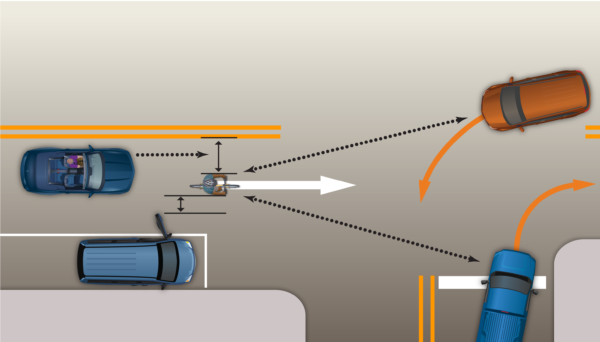
When you choose a high-vantage position, you can see potential conflicts and other drivers can see you. This position helps you avoid the side-swipe, right-hook, drive-out, left-cross – and prevents you from getting doored. For more, check out our FREE Essentials Course.
To Sum Up
Technology can be wonderful in bringing more people to bicycling. Using an e-bike is certainly FUN and COOL! However, if you are going to use an e-bike — for your safety and safety of others — you NEED to take important steps to learn how to interact with all users on-road and off to drive safely, legally, savvy, responsibly, cooperatively, and with confidence. Taking a CyclingSavvy course, online and/or in-person, will help with all of this!
Trek Bicycle Corporation has some good initial advice on “How to ride an electric bike safely” in text and video: “Start slow, brake sooner, brake lightly and evenly, ride with extra caution, and follow the rules on the road.”
Also see my article in Bicycle Retailer and Industry News, which is useful for everyone.
Next in this series: Flat tires and ebikes.
Clint Sandusky is a CyclingSavvy Instructor Candidate. He is a retired law enforcement officer after a 24-year career including both the Los Angeles County Sheriff’s and Riverside Community College District Police Departments. While at RCCDPD, he was a bike officer for 23 years.
He is a 26-year active and certified California Bike Patrol Instructor and currently instructs Bike Patrol Courses for the Riverside County Sheriff’s Department. He has been an IPMBA (International Police Mountain Bike Association) member since 1994 and is a former IPMBA instructor. Clint owns two e-bikes and runs errands, commutes, races, teaches, and patrols (at his church) on them. At the 2018 and 2019 IPMBA conferences, he presented/co-presented e-bike workshops to instructors and general attendees.
He has also presented e-bike seminars and presentations for local bicycle clubs, CABDA (Chicago Area Bicycle Dealers’ Association) Expos, and the Florida Bicycle Association. He has authored several e-bike-related articles for BRAIN (Bicycle Retailer and Industry News), CyclingSavvy, and IPMBA.

